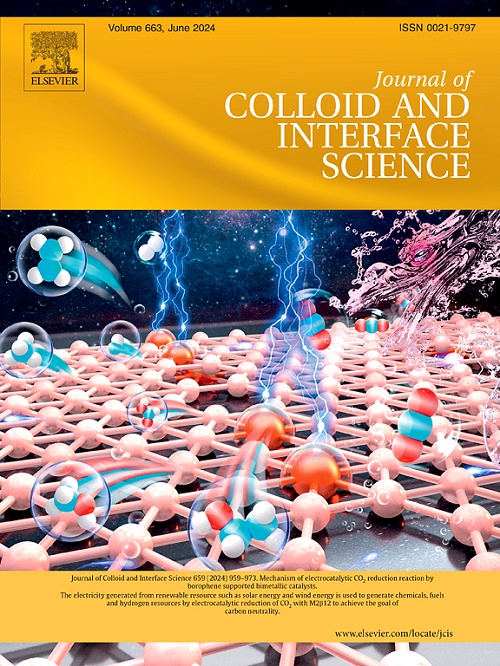纳米级钯- mo6s8 /碳纳米线用于高效电化学析氢和过氧化氢检测
IF 9.4
1区 化学
Q1 CHEMISTRY, PHYSICAL
引用次数: 0
摘要
chrel相(CP)硫化钼(Mo6S8)由于其独特的电子结构和丰富的开放通道,在能量转换和存储领域引起了广泛的研究关注。然而,对电催化双功能析氢反应(HER)和过氧化氢(H2O2)在cp基复合材料上传感的内在动力学机制的全面理解仍然缺乏。通过静电纺丝和热解将纳米级钯(Pd)和Mo6S8颗粒组装在碳纳米线(cnws)中。所获得的新型Pd-Mo6S8/C NWs具有优异的性能,在η为10时具有- 194 mV的低过电位,对H2O2的检测限为25 nM,灵敏度高达2231 μA mM−1 cm−2。实验和理论结果表明,Pd和Mo6S8纳米颗粒(NPs)具有优异的催化活性和强电子相互作用。这两种组分的协同作用可以有效调节反应物和中间体在催化剂表面的结合强度,最终提高小分子还原的电化学催化性能。此外,验证了电催化剂在各种环境下的稳定耐受性和良好的选择性,促进了基于Pd-Mo6S8/C nws的电化学传感系统在牛奶样品中附加H2O2的进一步应用,证明了该材料在实际应用中的广泛潜力。这项研究极大地促进了人们对纳米级和双功能cp基复合材料的认识。本文章由计算机程序翻译,如有差异,请以英文原文为准。

Nanoscale palladium-Mo6S8/carbon nanowires toward efficient electrochemical hydrogen evolution and hydrogen peroxide detection
Chevrel phase (CP) molybdenum sulfides (Mo6S8) have attracted extensive research attention in the field of energy conversion and storage due to their unique electronic structures and rich open channels. However, comprehensive understanding of intrinsic kinetic mechanisms governing the electrocatalytic bi-functional hydrogen evolution reaction (HER) and hydrogen peroxide (H2O2) sensing on CP-based composites is still lacking. Herein, nanosized palladium (Pd) and Mo6S8 particles were assembled in carbon nanowires (C NWs) via electrospinning followed by pyrolysis. The as-obtained novel Pd-Mo6S8/C NWs exhibited excellent performance in terms of a low overpotential of −194 mV at η10 for HER, and an ultrahigh sensitivity of 2231 μA mM−1 cm−2 with a limit of detection of 25 nM for H2O2 sensing. The experimental and theoretical findings demonstrated that Pd and Mo6S8 nanoparticles (NPs) exhibited exceptional catalytic activity and strong electronic interactions. The synergistic effects of these two components could effectively modulate the binding strength of reactants and intermediates on the catalyst surface, ultimately leading to improved electrochemical catalytic performance toward reduction of small molecules. Moreover, verification of the stable tolerance in various environments and good selectivity of the electrocatalyst promoted the further use of Pd-Mo6S8/C NWs-based electrochemical sensing system for sensing additional H2O2 in milk samples, proving the widespread potential of this material for practical applications. This study significantly advances the understanding of nanoscale and bi-functional CP-based composites.
求助全文
通过发布文献求助,成功后即可免费获取论文全文。
去求助
来源期刊
CiteScore
16.10
自引率
7.10%
发文量
2568
审稿时长
2 months
期刊介绍:
The Journal of Colloid and Interface Science publishes original research findings on the fundamental principles of colloid and interface science, as well as innovative applications in various fields. The criteria for publication include impact, quality, novelty, and originality.
Emphasis:
The journal emphasizes fundamental scientific innovation within the following categories:
A.Colloidal Materials and Nanomaterials
B.Soft Colloidal and Self-Assembly Systems
C.Adsorption, Catalysis, and Electrochemistry
D.Interfacial Processes, Capillarity, and Wetting
E.Biomaterials and Nanomedicine
F.Energy Conversion and Storage, and Environmental Technologies

 求助内容:
求助内容: 应助结果提醒方式:
应助结果提醒方式:


